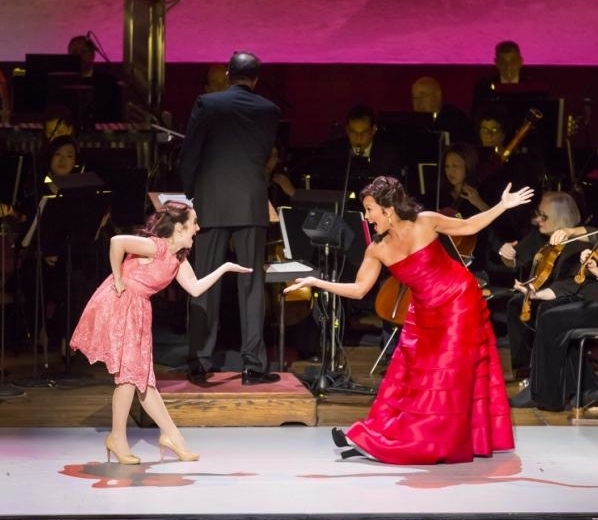Show Boat

(© Chris Lee)
The granddaddy of the American book musical has returned to New York. Show Boat, Jerome Kern and Oscar Hammerstein II's theatrical game changer inspired by Edna Ferber's novel, has sailed into Avery Fisher Hall for a concert production featuring the New York Philharmonic. Hewing closely to the original 1927 material (as opposed to various versions that have been edited over the years), Ted Sperling's semistaged concert is ravishingly sung by a cast led by Julian Ovenden and Lauren Worsham and majestically played by the 100-piece orchestra under Sperling's baton. But this production is only dramatically involving in fits and starts.
Show Boat tells the story of the relationship between rakish gambler Gaylord Ravenal (Ovenden) and the young Magnolia Hawks (Worsham), the daughter of show-boat purveyors Cap'n Andy (Fred Willard) and Parthy Ann Hawks (Jane Alexander). The young pair meet and fall in love while the ship is docked in Natchez, Mississippi, and quickly become the boat's two leading players when its former stars, the mixed-race Julie (Vanessa Williams) and her white husband, Steve (Edward Watts), are run out of town on miscegenation charges, this being 1887. Hammerstein, like the novelist Ferber, depicts 40 years in the lives of these characters, articulating the way views and relationships have the perverse ability to change significantly over time.
It's made very clear from the start that this is not a full production. Blocking is limited to simple movement around the small playing space. The one major set piece (by Allen Moyer) is a floor-to-ceiling backdrop of the titular show boat, Cotton Blossom, behind the orchestra. All of the performers are costumed (by Tracy Christensen) in tuxedos and gowns. The only real error in this concert production is the employment of Hammerstein's script, which has been abridged down to songs and major plot points, taking a back seat to the music.
Listening to these mostly glorious singers sink their teeth into Kern and Hammerstein's emotionally overwhelming score makes you wonder why dialogue was used at all, since it only detracts from the beauty of this kind of presentation. With the exception of Worsham and Williams (as well as the charming and always reliable supporting players Alli Mauzey and Christopher Fitzgerald), none of the principals have found their characters. It's especially disappointing in a case like the British-born Ovenden, whose versions of "Make Believe" and the eleven-o'clock reprise of "You Are Love" are stand-and-cheer-levels of magnificent. But they are relatively vacant in terms of line delivery. There's a similar blankness in the work of Norm Lewis, who looks strangely ill at ease in performing the role of Joe and the character's well-known ballad "Ol' Man River." Film character actor Willard and stage legend Alexander look like they're having a great time as Cap'n Andy and Parthy Ann, but the comic befuddlement they display simply doesn't fit in roles that need to be voices of reason.
Fortunately, there is thoroughly captivating work from Worsham and Williams. Their believable rapport elevates major shared book scenes toward the end of the first act into a dramatic high point. Individually, Williams is smoldering in a red gown designed by Carmen Marc Valvo. She brings the right amount of sensuality to the bluesy "Can't Help Lovin' Dat Man" and melancholy to the gorgeous second-act ballad "Bill." Worsham, meanwhile, late of Broadway's A Gentleman's Guide to Love and Murder, nearly runs away with the show. She seems to truly get inside Magnolia's head, adeptly charting her arc from lovestruck young lady to embittered older woman. In addition, she possesses a shimmering legit soprano put to particularly great use in the second half.
An ensemble numbering 29 provides splendid harmonies that wonderfully blend with the sumptuous orchestra. While we can wish that the book scenes were stronger (or cut altogether), to hear this music presented in this manner is an embarrassment of riches that shouldn't be missed.










